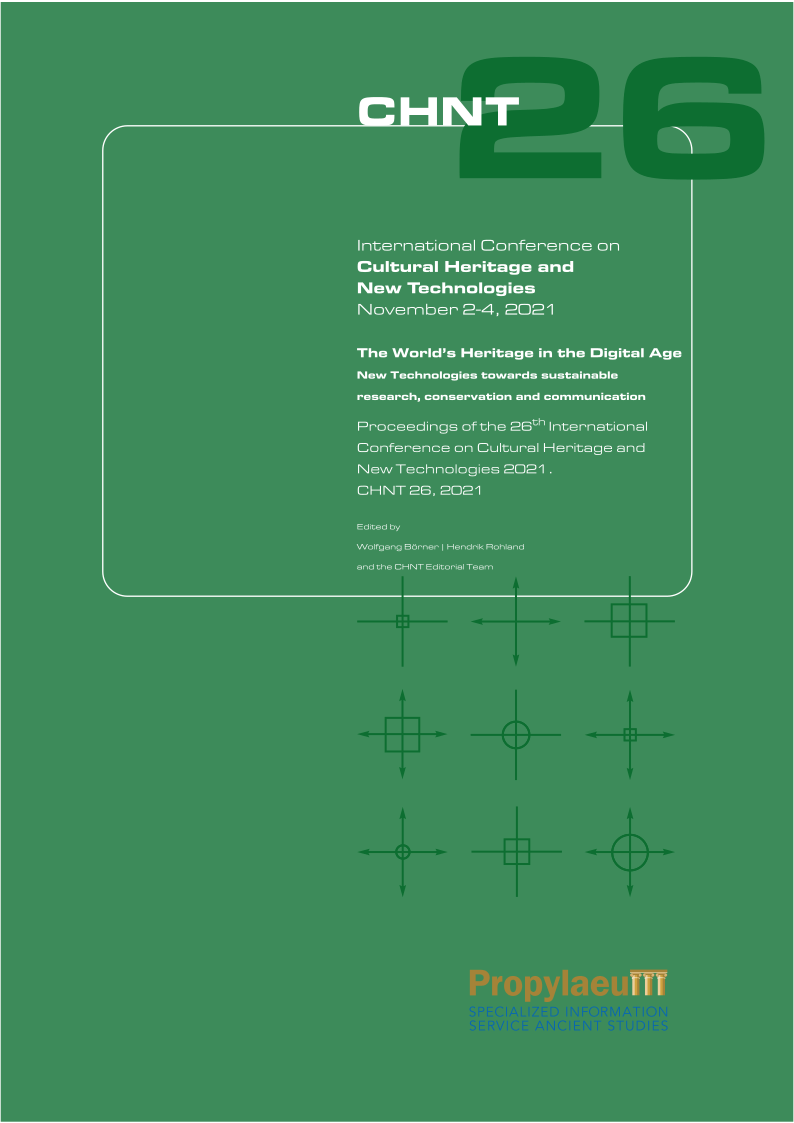Semantic topologies for complex medieval buildings and their annotation
Basic considerations for the description of historic architecture in the Semantic Web
Keywords:
Ontologies, Linked Data, Semantic Topology, Heritage Conservation, Architectural HistoryAbstract
Semantic technologies can be used not only to create ontologies as controlled vocabularies for historical architecture. Rather, they also make it possible to map the spatial and structural relationships within a building. Using an OWL ontology developed for the use in the MonArch system with a lean, non-event-oriented data model, it is shown how the relationships between the individual elements of a building (buildings parts, spatial units, structural components, architectural surfaces) have to be set. The result is a consistent structure graph and thus a semantic topology as an object-related data infrastructure that enables the interaction of different disciplines in heritage conservation in everyday practice. At the same time, it is connectable to other data models, such as CRMba.
References
Freitag, B. and Stenzer, A. (2017). ‘MonArch – A Digital Archive for Cultural Heritage’, in Franz, B. and Vinken, G. (eds.) Das Digitale und die Denkmalpflege. Bestandserfassung – Denkmalvermittlung – Datenarchivierung – Rekonstruktion verlorener Objekte. Heidelberg: arthistoricum.net, pp. 122–129. Available at: https://doi.org/10.11588/arthistoricum.263.348 (Accessed: 27 July 2021).
Guillem, A., Bruseker, G. and Ronzino, P. (2017). ‘Process, concept or thing? Some initial considerations in the ontological modelling of architecture’, International Journal on Digital Libraries 18(4), pp. 289–299. Available at: https://doi.org/10.1007/s00799-016-0188-0 (Accessed: 27 July 2021).
Kuroczyński, P., Brandt, J., Jara, K. and Grosse, P. (2019). ‘Historic Building Information Modeling (hBIM) und Linked Data – Neue Zugänge zum Forschungsgegenstand objektorientierter Fächer’, Proceedings of DHd2019. Digital Humanities: multimedial & multimodal, Universities of Mainz and Frankfurt. 25th – 29th March 2019, pp. 138–141.
Nöbauer, A. and Stenzer, A. (2020). ‘Modellierung komplexer Gebäudestrukturen als digitaler Sammlungsraum’, in Bienert, A., Emenlauer-Blömers, E., Hemsley, J. (eds.) Konferenzband EVA Berlin 2019. Elektronische Medien & Kunst, Kultur und Historie. 26. Berliner Veranstaltung der internationalen EVA-Serie Electronic Media and Visual Arts. Heidelberg: arthistoricum.net, p. 68–77. Available at: https://doi.org/10.11588/arthistoricum.645 (Accessed: 27 July 2021).
Petzet, M. and Mader, G. (1995). Praktische Denkmalpflege. 2nd edn. Stuttgart: Kohlhammer.
Ronzino, P., Niccolucci, F., Felicetti, A. and Doerr, M. (2016). ‘CRMba a CRM extension for the documentation of standing buildings’, International Journal on Digital Libraries 17(1), pp. 71–78. Available at: https://doi.org/10.1007/s00799-015-0160-4 (Accessed: 27 July 2021).
Ronzino, P., Niccolucci, F., Felicetti, A., Doerr, M. et al. (2016). Definition of the CRMba. An extension of CIDOC CRM to support buildings archaeology documentation. Available at: https://cidoc-crm.org/crmba/sites/default/files/2016-12-3%23CRMba_v1.4.1_UR.pdf. (Accessed: 25 January 2022)
Ronzino, P. (2019). ‘CRMba: An ontological model for encoding buildings archaeology documentation’, in Kuroczyński, P., Pfarr-Harfst, M. and Münster, S. (eds.) Der Modelle Tugend 2.0. Digitale 3D-Rekonstruktion als virtueller Raum der ar-chitekturhistorischen Forschung. Heidelberg: arthistoricum.net, pp. 354–370. Available at: https://doi.org/10.11588/arthistoricum.515 (Accessed: 27 July 2021).
Stenzer, A., Ehrlinger, Ch. and Schmid, M. (2019). ‘Ansätze zur semantischen 3D-Repräsentation von Bauwerken in Daten-banken’, in Kuroczyński, P., Pfarr-Harfst, M. and Münster, S. (eds.) Der Modelle Tugend 2.0. Digitale 3D-Rekonstruktion als virtueller Raum der architekturhistorischen Forschung. Heidelberg: arthistoricum.net, pp. 372–390. Available at: https://doi.org/10.11588/arthistoricum.515 (Accessed: 27 July 2021).
Downloads
Published
Conference Proceedings Volume
Section
License
Copyright (c) 2025 Leonhard Salzer, Tobias Arera-Rütenik, Alexander Stenzer

This work is licensed under a Creative Commons Attribution-ShareAlike 4.0 International License.
The CHNT older Proceedings are licensed under the creative commons license CC BY-NC-ND 3.0.
From the issue 26 on, they will be licensed under the creative commons license CC-BY-SA 4.0


